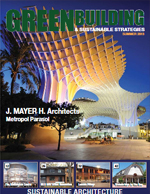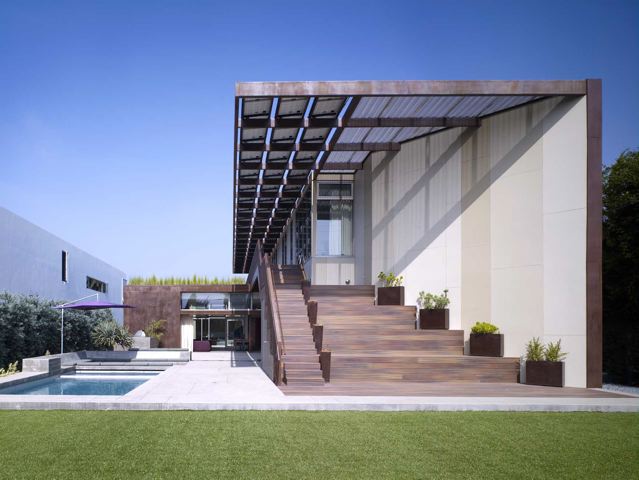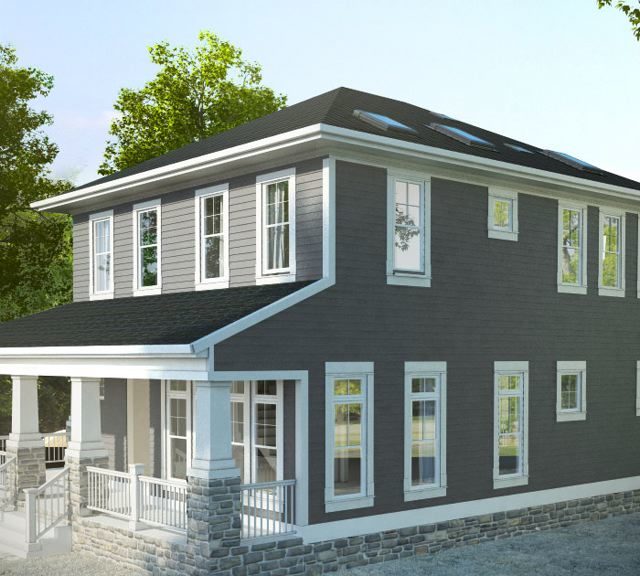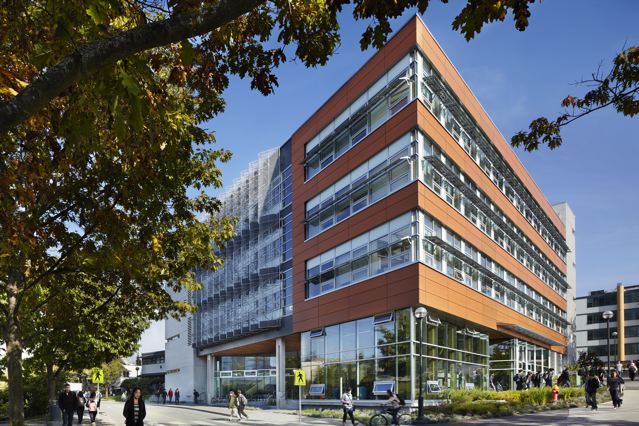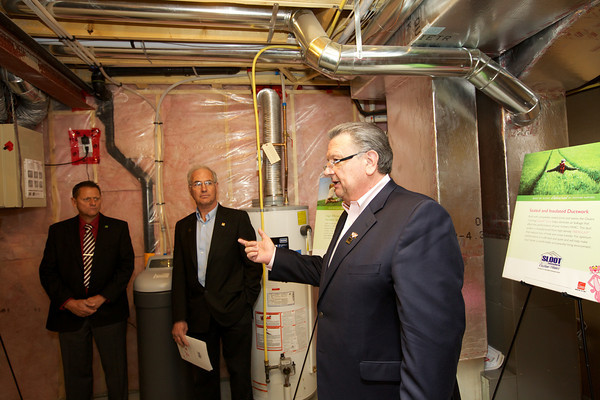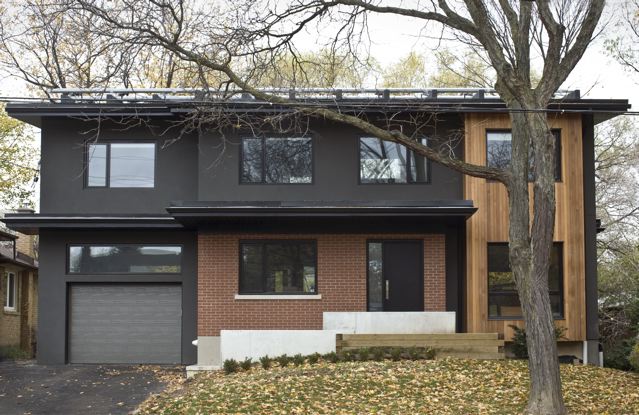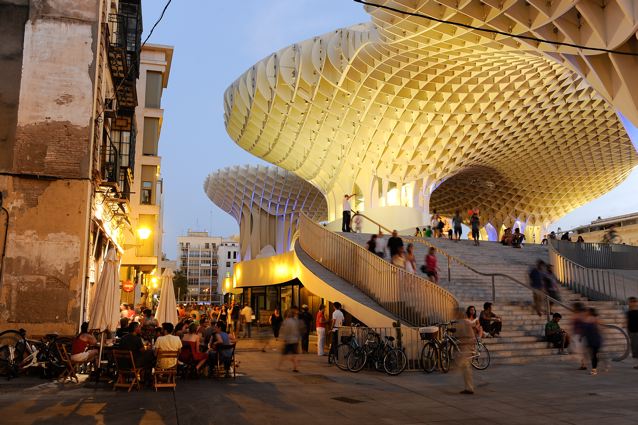All posts by Giulio
Stonebridge by the Bay
Wasaga Beach community billed as ‘the total package’ still going strong after 12 year
Some might say it’s like living in another place and time.
But that’s not all they would say about Stonebridge by the Bay, the unique residential complex and community in Wasaga Beach that’s still going strong after 12 years of work and planning.
Just six years ago, Stonebridge by the Bay was mostly a vision and untamed green space.
Now, however, the project is entering Phase 5 of its ongoing evolution.
The focus remains the same – a bustling community of engaged and connected residents and businesses that are taking advantage of the “changing-your-lifestyle-for-the-better” mentality.
Stone gates mark the entrance to Stonebridge by the Bay where the architecture reflects a mix of 1920s Wasaga Beach and Cape Cod design sentiments.
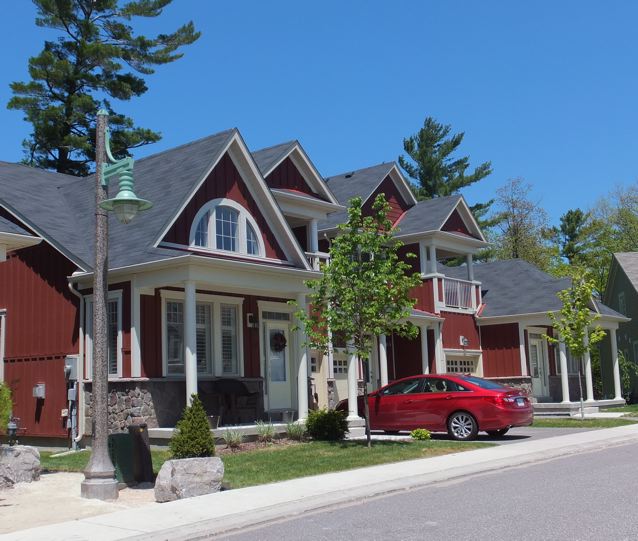
The riverside community is connected by 2.1 kilometres of walking trails, which lead to other homes and a commercial area called the Stonebridge Town Centre.
This town centre feature makes Stonebridge an almost self-contained community within the larger town of Wasaga Beach. The centre has restaurants such as Harvey’s-Swiss Chalet, Boston Pizza, major retailers such as the Wal-Mart Superstore, EB Games, The Source, Living Lighting, an optometrist, a dentist and a Canada Trust branch. And more shops are planned.
It’s quite common to see people cycling and strolling through the community, often meeting for social events held by residents, taking in live music at a restaurant, doing a little shopping, or using the medical and professional services. And it’s all within walking distance, as is the world-famous beach.
There are nearly 23 acres of open space parkland, which include two ponds and shady tree-covered areas to relax in. Over the years, in fact, Stonebridge has added the free long-weekend Wasaga Beach Blues Festival, featuring Canada’s best in blues including Downchild, Jack de Keyzer and Paul James.
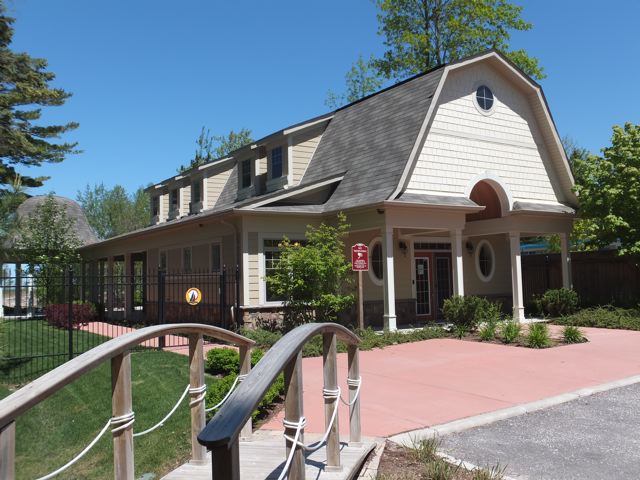 Complementing the park experience is the luxurious and private Stonebridge Beach Club, billed as a great place to relax, entertain and further foster a sense of community.
Complementing the park experience is the luxurious and private Stonebridge Beach Club, billed as a great place to relax, entertain and further foster a sense of community.
Backing on to the Nottawasaga River, the club features breathtaking views, a patio, a lounge, meeting room and a stunning fireplace. Homeowners also have exclusive use of an outdoor, heated, saltwater pool, complete with cabana.
Stonebridge by the Bay homes also have Energy Star-certified features such as low-E argon-filled windows, extra insulation, a high efficiency two-stage furnace, and a high-efficiency heat recovery ventilator.
Complementing the existing mix of housing styles, including bungalows and two-storey villas, Phase 5 will feature low-rise condominiums with two-bedroom suites and the only condo apartment building in Wasaga Beach with covered parking.
And the new models, according to Stonebridge marketing, will back onto the trails and woodlots, so “you’ll be surrounded by beauty.”
Also, some of the standard features at Stonebridge, offered by developer Hamount Investments Ltd., include other builders’ upgrades which are aimed at enhancing the homeowners’ living space and lifestyle.
Dubbed “the total package,” Stonebridge continues to help reinvent Wasaga Beach – while giving homeowners there the opportunity to reinvent themselves at the same time.
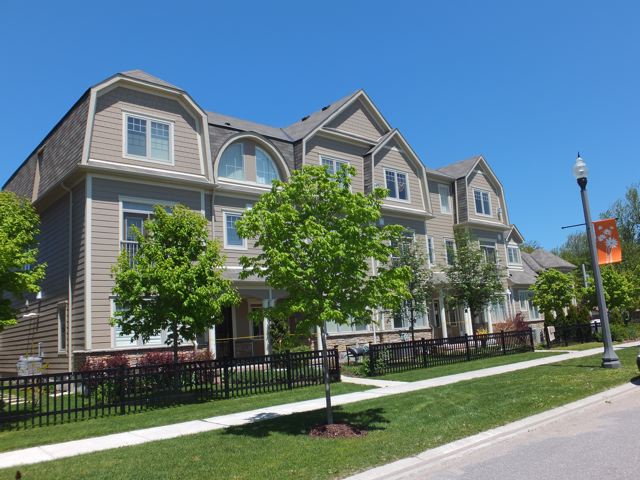
“Stonebridge has been designed as pedestrian-friendly, active community that offers residents more than just a collection of houses.”
In other words, then: The total package.
Web: mystonebridge.ca
The American Institute of Architects Select the 2013 COTE Top Ten Green Projects
Projects showcase excellence in sustainable design principles and reduced energy consumption
The American Institute of Architects (AIA) and its Committee on the Environment (COTE) have selected the top ten examples of sustainable architecture and green design solutions that protect and enhance the environment. The projects will be honored at the AIA 2013 National Convention and Design Exposition in Denver.
The COTE Top Ten Green Projects program, now in its 17th year, is the profession’s best known recognition program for sustainable design excellence. The program celebrates projects that are the result of a thoroughly integrated approach to architecture, natural systems and technology. They make a positive contribution to their communities, improve comfort for building occupants and reduce environmental impacts through strategies such as reuse of existing structures, connection to transit systems, low-impact and regenerative site development, energy and water conservation, use of sustainable or renewable construction materials, and design that improves indoor air quality.
#10
Charles David Keeling Apartments; La Jolla, California
KieranTimberlake
The design response was to tune the design to capitalize on the favorable environmental features, while moderating or eliminating the undesirable ones. This led to a building envelope that uses thermal mass to buffer temperature changes, minimizes solar gain, and naturally ventilates. Water scarcity is managed through a comprehensive strategy of conservation and reuse, including on-site wastewater recycling. A vegetated roof, an unusual feature in this dry climate, absorbs and evaporates rain that falls on that portion of the building, with overflow directed to the courtyard retention basins.
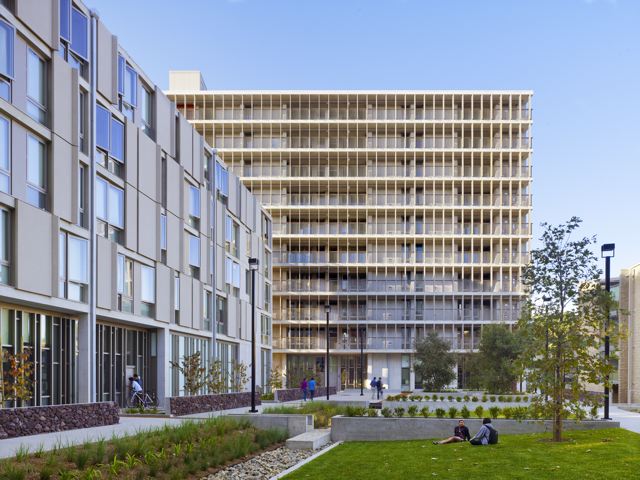
#9
Clock Shadow Building; Milwaukee
Continuum Architects + Planners
This project cleans up a brown-field site that was difficult to develop. The continental climate provides large swings in temperature and humidity which necessitated passive strategies such as: southern facing windows with sun screens that maximize insolation of the sun during cooler months and operable windows that let cool fresh air into the building, allowing the users to effectively “turn off” the heating and cooling systems during swing months. To gain the most efficiency from the HVAC systems, the project utilizes a geo-thermal system, drilled directly below the building, which stabilizes the temperature of the conditioned water used to heat and cool the spaces.
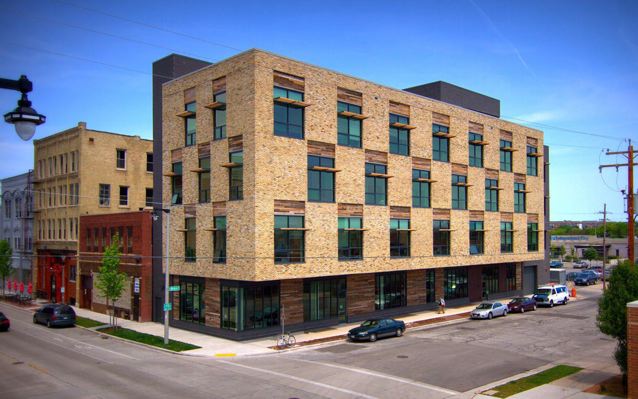
#8
Federal Center South Building 1202; Seattle
ZGF Architects LLP
Current energy models predict the building to operate at a “net zero capable” Energy Use Intensity (EUI) of 20.3 kBtu/SF/year, performing 40 percent better than ASHRAE 2007. The building will earn an ENERGY STAR Score of 100 and comply with 2030 Challenge goals. The project is one of the first in the region to use structural piles for geothermal heating and cooling, as well as a phase change thermal storage tank. Two new products, chilled sails and open office lighting, were developed and manufactured specifically for this project to help achieve aggressive energy targets. To optimize the use of the available reclaimed timbers, the team designed, tested, and constructed the first wood composite beam system in the U.S.
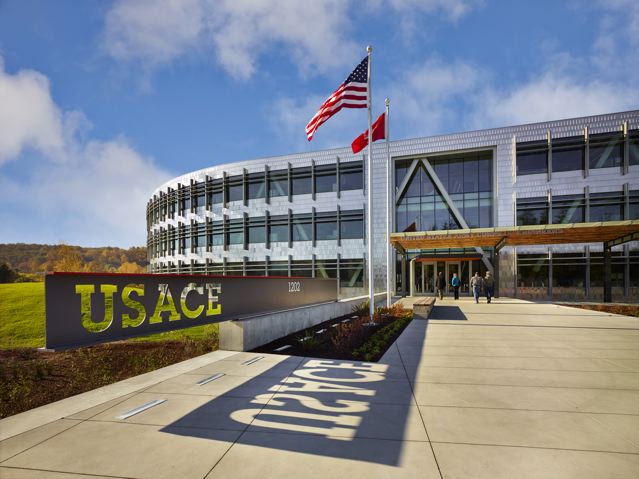
#7
Marin Country Day School Learning Resource Center and Courtyard; Corte Madera, California
EHDD
Around 95 percent of spaces are daylit and naturally ventilated. Night time operation of the cooling tower and an underground water tank provide active thermal storage, for daytime cooling. The design of the building envelope includes air tightness detailing and the use of fire treated wood stud framing to minimize thermal bridging. To provide an excellent thermal envelope, walls were constructed with 2×8 and 2×10 wood studs (rather than conventional steel studs) to minimize thermal bridging and provide ample insulation. This building is designed to achieve an EUI of 6.74 kbtu/sf/yr including the energy generated by the PV array, and to use less than half as much energy as California’s strict energy code.
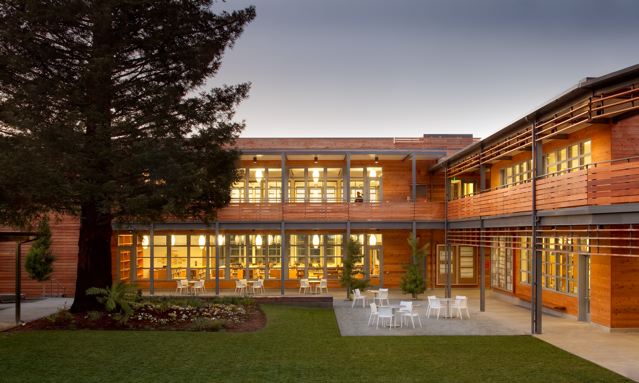
#6
Merritt Crossing Senior Apts.; Oakland, California
Leddy Maytum Stacy Architects
The roof area has a cool roof surface and is devoted to both a solar water panels and photovoltaic panels. Ground floor spaces benefit from the full height storefront system that similarly provides ample daylight and transparency to the outdoors. These windows are also thermally broken and have high performance glass. The windows are shaded in summer by either exterior sunshades or an overhang from the second floor. With no mechanical air conditioning, cooling is achieved by a low volume ventilation system augmented by ceiling fans in each habitable room. The site has a 94 walkability rating, an 82 transit rating
and an 86 bike friendly rating from walkscore.com.
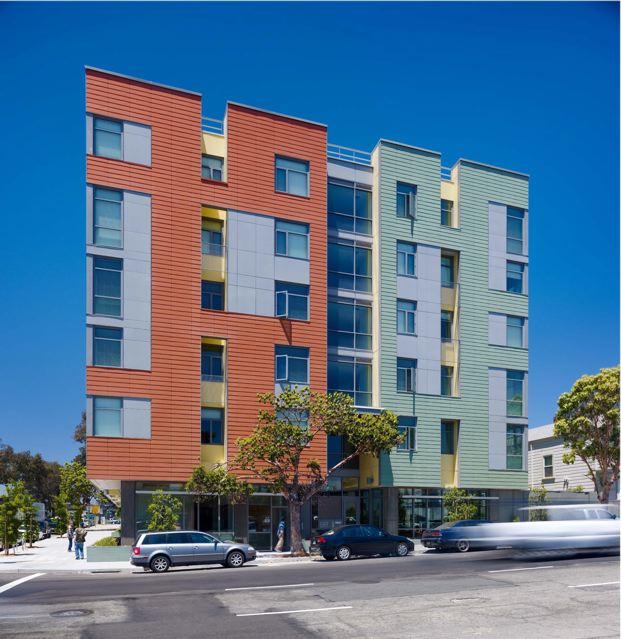
#5
A New Norris House; Norris, Tennessee
College of Architecture & Design, UT Knoxville
At 1008 square foot, this production house is less than half the size of the median house. “Rightsizing” reduced material and operational loads and costs, and shifted funds to quality design and construction, passive strategies and high-efficiency systems. The dormer and skylight are placed so daylight is reflected and diffused. No-VOC paint color is warm white with a punch of red-orange hidden within the swing space to produce a warm glow from reflected light. Low-E glass and translucent blinds provide further control over heat, glare and privacy. All interior rooms are daylit throughout the day. Electric lighting is integrated with cabinetry and includes low-energy LEDs.
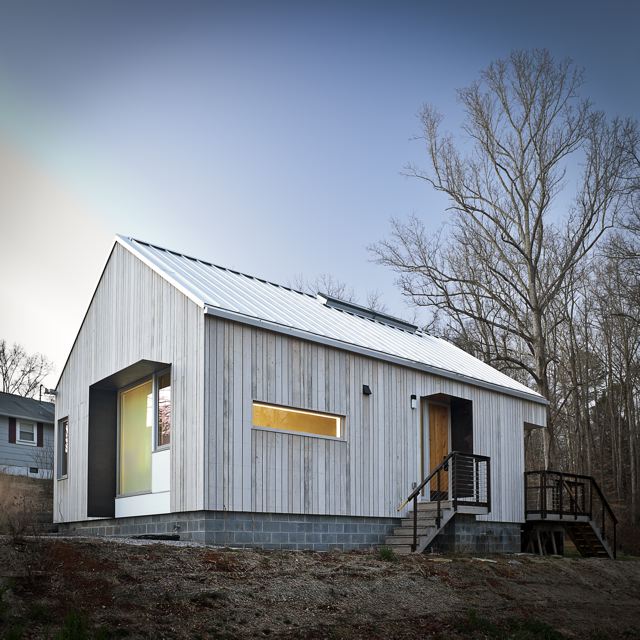
#4
Pearl Brewery/Full Goods Warehouse; San Antonio
Lake Flato Architects
This 67,000 square foot LEED Gold warehouse includes passive solutions including open breezeways, which were carefully oriented to prevailing summer breezes and supplemented with large ceiling fans. Large light monitors oriented to the north provide natural daylight to the breezeways, while the south wall of the cupola is open to allow hot air to escape as it rises. 100% of the rainwater captured from roofs coupled with recycled water, is used to irrigate the landscaping on site, eliminating the need for potable irrigation water. Highly efficient ductless minisplit systems were installed to condition indoor spaces. These systems can serve multiple zones using only one outdoor unit, and allows individual control of the air conditioning in each room.
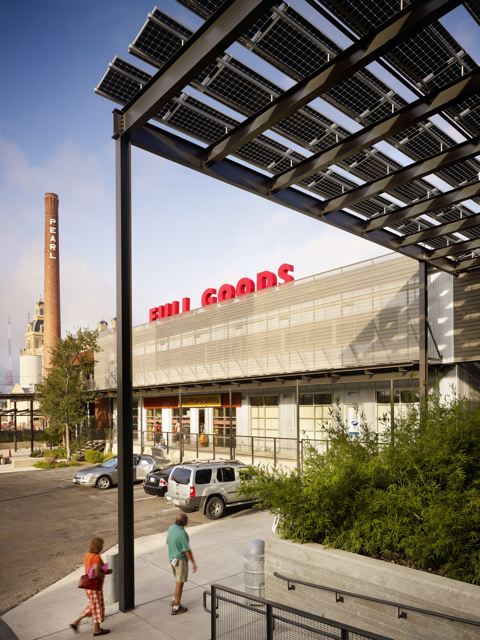
#3
San Francisco Public Utilities Commission Headquarters (SFPUC); San Francisco
Joint Venture: KMD Architects w/ Stevens & Associates
The building is designed to achieve LEED Platinum certification and will exceed California’s recently-instituted Title 24 requirements for energy efficiency in new office buildings by 55% according to SFPUC estimates. The building will produce up to 7% of its own power needs from renewable photovoltaic and wind sources; will provide $118 million in energy cost savings over 75 years; and will require 45% less energy to illuminate the interior through daylight-harvesting and advanced lighting design, compared to typical Class A office buildings. The SFPUC consumes 60% less water than similarly sized buildings and is one of the first buildings in the nation with on-site treatment of gray and black water.

#2
Swenson Civil Engineering Building; Duluth, Minnesota
Design Architect: Ross Barney Architects
Architect of Record: SJA Architects
As an educational facility whose curriculum directly impacts the natural environment, the building overtly exposes sustainable systems and materials. 73% of the site is devoted to pervious materials and landscaping, reducing site detention requirements. An extensive green roof with native plants covers 22% of the roof, reducing storm water rates and filtering impurities. Storm water is directed from the roof to three scuppers and into above ground cylinders filled with rocks for filtering. Storm water eventually makes its way to a French drain system of underground water storage pipes for retention. The site lighting is minimal, and all fixtures are equipped with full cut-off optics.
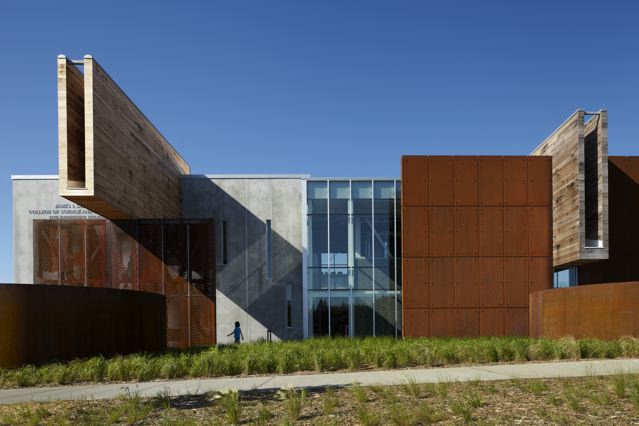
#1
Yin Yang House; Venice, California
Brooks + Scarpa
This sound passive design strategy combined with a very tight perimeter building envelope and other active sustainable features such as the 12kw solar system make this home a zero energy consumption home. It produces 100% of its energy needs and since completion, has never received an electric bill. The design maximizes the opportunities of the mild, marine climate with a passive cooling strategy using cross-ventilation and a thermal chimney. A large cantilevered roof overhang shades all the bedrooms from direct sunlight while providing ample natural light and ventilation. The project also has green roofs, its own storm water retention system and retains 95% of roof storm water on site.

Brooks + Scarpa
Yin-Yang House
Location of Project: Venice, CA
Total Square Footage: 4200 sq. ft.
Total Cost: $1.7 mil
The Yin-Yang House is a net-zero energy single-family home in a quiet Venice, CA neighborhood. The design objective was to create a space for a large and growing family with several children, which would create a calm, relaxed and organized environment that emphasizes public family space. The home also serves as a place to entertain, and a welcoming space for teenagers as they seek social space with friends.

The home is organized around a series of courtyards and other outdoor spaces that integrate with the interior of the house. Facing the street the house appears to be solid. However, behind the steel entry door is a courtyard, which reveals the indoor-outdoor nature of the house behind the solid exterior. From the entry courtyard, the entire space to the rear garden wall can be seen; the first clue of the home’s spatial connection between inside and out. These spaces are designed for entertainment, and the 40 foot sliding glass door to the living room enhances the harmonic relationship of the main room, allowing the owners to host many guests without the feeling of being overburdened.
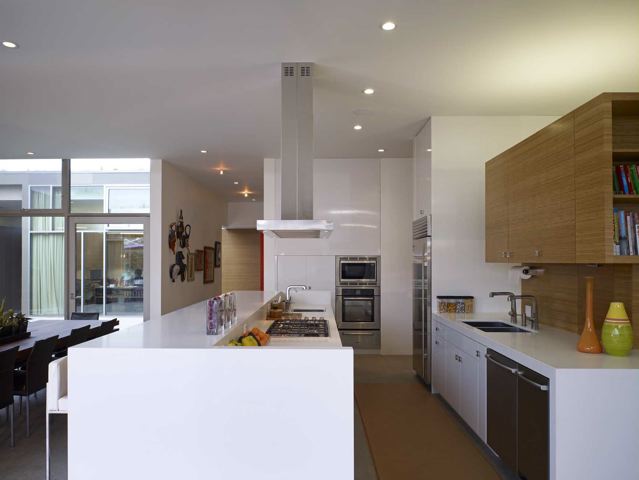
The tensions of the house’s exterior are subtly underscored by a 12-inch steel band that hews close to, but sometimes rises above or falls below the floor line of the second floor – a continuous loop moving inside and out like a pen that is never lifted from the page, but reinforces the intent to spatially weave together the indoors with the outside as a single space.
Scale manipulation also plays a formal role in the design of the structure. From the rear, the house appears to be a single-story volume. The large master bedroom window and the outdoor steps are scaled to support this illusion. It is only when the steps are animated with people that one realizes the true scale of the house is two stories.
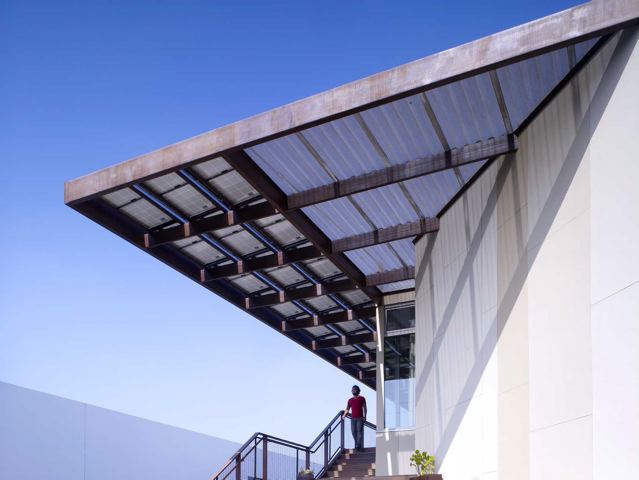
The kitchen is the heart of the house, with an open working area that allows the owner, an accomplished chef, to converse with friends while cooking. Bedrooms are intentionally designed to be very small and simple; allowing for larger public spaces, emphasizing the family over individual domains. The breakfast room looks across an outdoor courtyard to the guest room/kids playroom, establishing a visual connection while defining the separation of uses. The children can play outdoors while under adult supervision from the dining area or the office, or do homework in the office while adults occupy the adjacent outdoor or indoor space.
Many of the materials used, including the bamboo interior, composite stone and tile countertops and bathroom finishes are recycled, and reinforce the environmental DNA of the house, which also has a green roof. Blown-in cellulose insulation, radiant heating and a host of other sustainable features aids in the performance of the building’s heating and cooling.
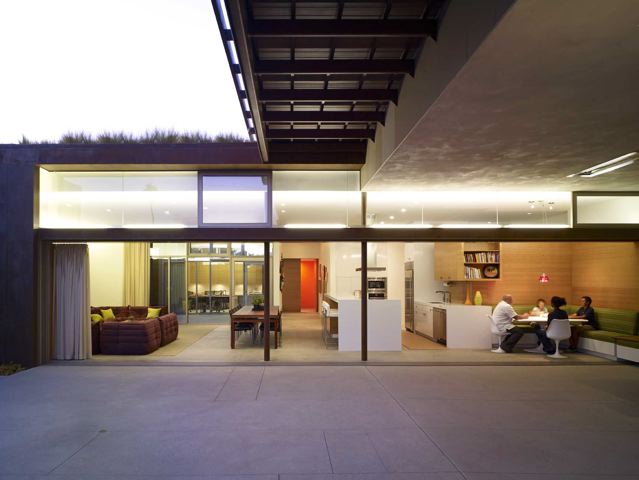
The active systems in the home include a 12 KW solar photovoltaic panel system, the largest such residential system available on the market. The solar panels also provide shade from the sun, preventing the house from becoming overheated. The owners have been in the home for over nine months and have yet to receive a power bill.
Photography: John Linden
A benchmark in North America
Innovative sustainable home near St. Louis certified as industry’s first Active House
An innovative sustainable building project near St. Louis, Missouri, has been certified as the first Active House in North America.
Not to be confused with a Passive House designation, an Active House is one that incorporates a comprehensive, exceptionally-green design both inside and out.
Designed by Jeff Day Architect, and built by Hibbs Homes & Verdatek Solutions, the Smith house in Webster Groves, Missouri, is an industry-innovating sustainable home that is the first in North America to be certified to the Active House Alliance standards. The home is also certified for Energy STAR, ANSI ICC-700, Builder’s Challenge Home, EPA Indoor Air Quality, and EPA Water Sense metrics.
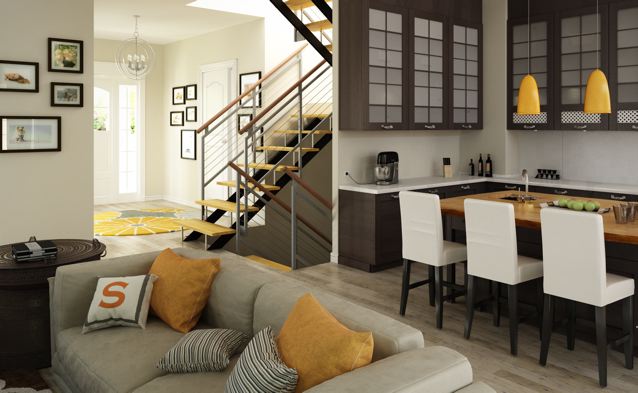
A culmination of the leading green, sustainable, and environmentally-conscious building practices from around the world and in the U.S., Active House takes a unique and holistic approach to sustainable and environmentally conscious home construction and design.
Other homes have been built internationally under the Active House umbrella, utilizing Active House specifications, in countries such as Portugal, Austria, Norway, United Kingdom, Italy, Netherlands, and Russia.
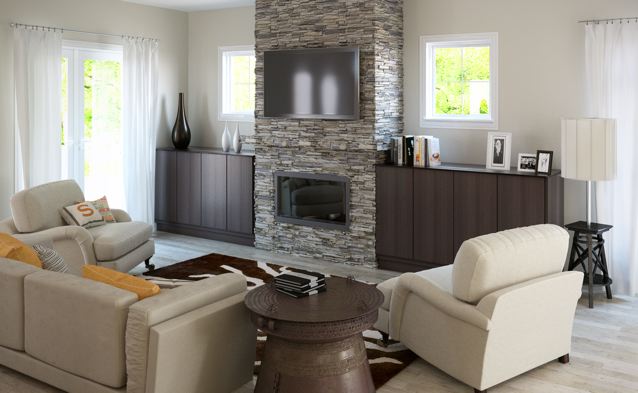
The Active House standard was created by window manufacturer, Velux, to provide an alternative vision of sustainable housing – one that includes more windows than a typical Passive House.
Active House uses state of art energy-efficient materials, design techniques and building practices that rely on renewable resources from design to construction and through the life of the home.
Energy efficiency in the Smith home is made possible by solar orientation, solar energy collectors, airtight building envelope, HVAC and water heating design, use of daylight, and natural ventilation.
Passive House versus Active House
Both Passive House and Active House models are sustainable and environmentally-friendly. The difference is that Passive House focuses on conserving energy through a combination of air-tight building materials, superinsulation, advanced window technology and designing the house to achieve maximum solar gain, resulting in ultra-low energy buildings that require little energy for space heating or cooling. Even the expected body heat of the building occupants is factored into the calculations.
Instead of focusing on environmentally-friendly ways to produce energy, passive houses cut the need for energy consumption in the first place—by as much as 90 per cent compared with the average home.
Active House takes an innovative approach to energy efficiency, indoor air quality, and interaction with the surrounding environment.
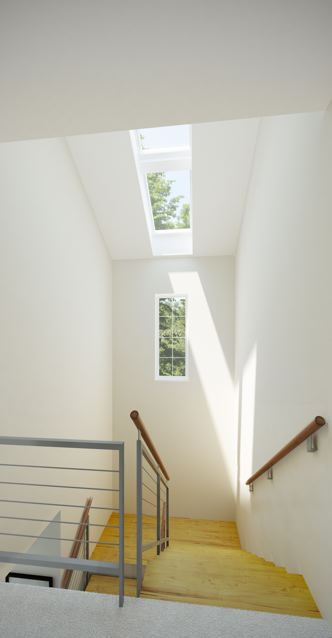
While most of the green building standards concern materials and building processes, Active House standards are the first to account for those, while primarily focusing on what happens when the homeowners take up residence.
The immediate goal is to provide the homeowner with a cost-effective and easy to operate and maintain living space, that creates healthier and more comfortable lives for their occupants without impacting the climate.
In short, Passive House has a singular focus on energy efficiency, while the Active House expands the focus to quality of life issues, such as indoor air quality, fresh air, and natural sunlight.
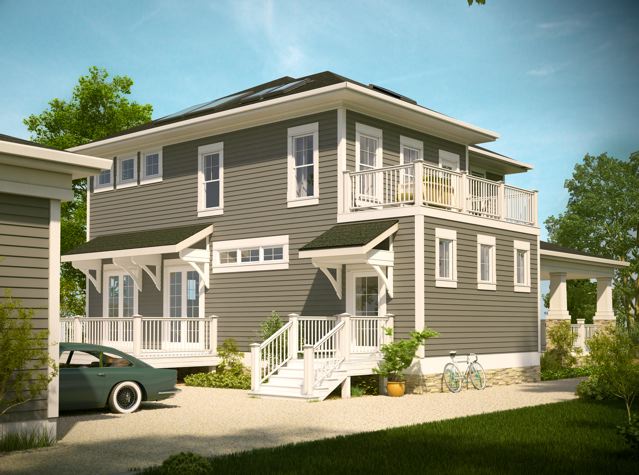
Web: www.activehouseusa.com
Wood Solutions – Innovations and Opportunities for the 21st Century
By Adam Robertson, M.A.Sc., EIT
When Gustave Eiffel, proposed building a skeletal steel structure for the Paris World Fair, he was ridiculed by professional engineers and most of high society in France. The tower was built for the 1889 Fair and instead of being torn down as initially suggested, became the most recognized and enduring cultural icon of France.
The 320 metre tall tower was the tallest structure in the world for more than 40 years and changed the world’s perception toward tall buildings.
If the first dozen years are any indication, wood is poised to undergo its renaissance in the 21st century. Increasingly, wood is being specified as the material of choice as advancements in wood science, design skills, and connection technology merge with the environmental aspirations of designers, governments, and occupants. Wood is no longer limited to houses and low-rise structures.
Major regulatory changes have occurred in North American and around the world to reflect the surge in awareness of the performance capabilities of wood. Over the past two decades, wood building technologies and design methods have advanced significantly in the areas of structural, fire safety, and energy performance. In 2009, mid-rise (up to six-storeys) wood-frame construction was approved in the British Columbia Building Code, with the Province of Quebec making similar amendments in April 2013.
In response to drivers such as cost savings and environmental benefits, building industry stakeholders are moving toward National Building Code (NBC) changes that would allow the construction of taller wood-frame buildings across Canada. The Joint Task Group on Combustible Construction has proposed to implement new mid-rise provisions for the 2015 National Building Code of Canada. This proposal includes the increase in allowable height from four- to six-storeys for both residential and business occupancies, along with increased levels of fire protection, such as sprinklers throughout the building.
The potential for wood in taller buildings does not stop at six-storeys. Several Canadian manufacturers are now producing massive timber engineered wood products such as cross laminated timber (CLT), laminated veneer lumber (LVL), and laminated strand lumber (LSL). With these products, it is now possible to design and construct even higher wood buildings. The world’s tallest residential wood building was recently completed in Melbourne, Australia, reaching a height of ten-storeys. There are other examples of seven-, eight-, and nine-storey wood structures in the U.K., Scandinavia, and Central Europe. Here in Canada, there are many examples of innovative, high-performance wood building designs and construction; including the Centre for Interactive Research on Sustainability and the Earth Sciences Building, both at the University of British Columbia, Vancouver, as well as the Fondaction building in Québec City.
While the increased structural performance capabilities of wood products may be new to many designers, the environmental performance of wood is well recognized and appreciated by many.
From an environmental perspective, wood products and building systems have several advantages, including operational energy savings, low embodied environmental impacts, and carbon storage. Compared to other structural materials, wood has exceptional thermal performance, due to its much higher heat resistance value. Wood insulates 10 times better than concrete and 400 times better than steel. The natural structure of the wood fibre, virtually identical to a drinking straw, allows wood building products to trap air within the cells, enhancing its thermal capabilities and helping save the use of operational energy over the course of the building’s lifetime.
A number of life cycle assessment (LCA) studies from around the world have demonstrated that bio-based building products and systems are less environmentally impactful throughout their life cycle (raw materials acquisition, manufacturing, transportation, use, and end-of-life) when compared to other building materials. In addition, substituting wood in place of other more fossil fuel-intensive materials reduces overall GHG emissions that would have otherwise been emitted during the production of these non bio-based materials. Wood building products, such as lumber, panels, and decking, continue to store the carbon which was initially absorbed as CO2 by the trees during their growing cycle. While a new tree is growing, this carbon is locked-up and kept out of the atmosphere, enabling wood products to act as carbon sinks over the course of their service life.

Materials Matter
LCA is now a well-developed science and has been incorporated in building design and rating tools around the world. While operational impacts of structures still dominate the design considerations, the embodied impacts of materials will become more significant as operational efficiencies increase.
As the importance of embodied impacts become more apparent, LCA is the foundation for development of Environmental Product Declarations or EPDs – a standardized method of quantifying the environmental impacts of a building material, manufactured product or system. Typically, the EPD for a product will include information covering extraction, manufacturing processes, energy and water use, toxicity, emissions to air, soil, water and solid waste. An EPD can be used by design teams to evaluate the potential environmental impacts of alternative building material choices.
In some European counties, EPDs are now legal requirements for products – and North America is not far behind.
Some of the first North American EPDs developed for use by the building sector were for wood. The Western Red Cedar Lumber Association commissioned EPDs for some of their products. Several other wood product EPDs are scheduled to be released by the end of 2013. Designers will then be able to evaluate which materials have the lowest impact and are thus best suited for a particular function.

Regulatory changes
New codes affecting building height are not the only changes. Energy performance levels are increasingly becoming enshrined as well. This too provides greater opportunities for effective use of wood. Thicker walls can provide greater cavity space for insulation. New pre-fabrication methods increase structural accuracy and can significantly improve air tightness, thereby reducing both heat loss and moisture issues. Wood fibre insulation, thick walls and breathable panels are now common in Passive buildings in Europe and are making inroads in the North American market.
Why Wood?
As design teams, builders, and occupants strive to reduce the environmental footprint of their buildings, wood can play a critical role – from the sustainably managed forests of Canada to the diversity of new structural products and systems – designers will be able to achieve buildings and performance levels they wouldn’t have thought possible 40 years ago.
In the 19th century, Gustave Eiffel was no doubt asked ‘Why steel?’, but he persevered and revealed to the world a new way to build.
In the 21st century, some might well ask the question ‘Why wood?’
No other material has as many sustainable attributes as wood. Think about it – wood is renewable, recyclable, reusable, organic, biodegradable, strong, lightweight, ductile, diverse, easy-to-use and inexpensive. It stores carbon, produces oxygen, cleans the air we breathe and the water we drink, provides habitat and recreation opportunities in the forest and is the only major structural material grown by the sun. The challenge we face is to understand how this material works, how to integrate into our designs and to strive to even greater heights than we thought possible with wood.
So maybe the real question for the 21st century isn’t ‘Why wood?’; perhaps it is ‘If not wood, what?’
Ahead of the curve
Sloot Construction’s custom home in Guelph receives first certification in Canada in new Energy Star for New Homes standard
John Sloot realizes his company is a step ahead when it comes to being a construction industry leader in energy efficiency.
But he thinks the standards set by Sloot Construction Ltd., when it comes to high-performance levels in homes his company is building, will one day become the norm.
For now, though, he can take special pride in the fact that Sloot Construction has been recognized as the builder of the first home in Canada qualified under the new Energy Star for New Homes (ESNH) standard.
In layman’s terms, that means that the home in Guelph is over 20 per cent more energy efficient that others conforming to the minimum building code standards in Ontario.
“The more efficient your home is today the more you will keep on saving as others continue to pay more,” said Mr. Sloot, President of the Guelph and District Home Builders’ Association and President of Sloot Construction. “In the not-too-distant future this will be our normal building practice.”
The home, owned by Andy Goyda, is a 2,000-square-foot, three-bedroom bungalow in Sloot Construction’s Hale’s Manor Phase 11 community and is expected to provide an extra $600 a year in energy saving costs. Impressive numbers when you consider implementing extra energy efficiency features only added about $4,000 to the cost.
Stringent standards for the Energy Star certification have been put in place by Natural Resources Canada. An independent energy evaluator inspects and verifies each home, with the federal government’s EnerQuality Corp. on hand to observe the process.
There are a number of features in each home that are taken into consideration when an evaluation is conducted.
Some of those include:
- High-performance windows;
- Energy Star-rated appliances;
- Insulation upgrades;
- Higher-efficiency heating;
- Superior draft-proofing;
- And higher-efficiency air-conditioning.

Mr. Sloot says he is very happy with the air tightness results in the Goyda home.
“It turned out better than we expected,” he says. “We continue to find better ways to improve air tightness, which will only bring more savings to the homeowner.
“Overall, we were very satisfied with the energy efficiency results of the Goyda home and, better yet, the owners are extremely pleased and comfortable in their new home.”
He says that EnerQuality was very supportive of his company’s efforts to raise the energy efficiency bar with the Goyda home.
“EnergQuality offered any technical support to achieve energy efficiency and Energuide 86, which is the new measuring tool.”
Mr. Goyda, a market development manager/ Canadian builder lead at Owens Corning Canada, who works with builders such as Sloot Construction across the country, raved about how quiet his home is.
“It’s very quiet because of its air tightness and the house has no hot or cold spots,” he says. “All the rooms have an even temperature, in summer and in winter.
“The ERV (energy recovery ventilation) system acts as the lungs of the home and provides the right amount of fresh air while exhausting stale air.
“From a builder perspective, the best bang for the builder’s dollar is a super tight and super insulated envelope. That means the other decisions the builder makes – such as right sizing furnaces and ducts – can be less expensive.”
Mr. Sloot says more and more homeowners these days ask him about energy efficiency options that should be included when they build a new home.
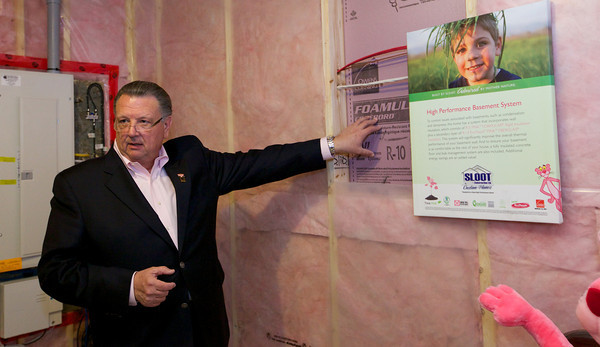
“We have typically offered different types, such as in-floor heat in basements, upgraded insulation packages, upgraded/better air barriers/building envelopes and better windows,” he adds.
“Now we are offering a total package that includes an all-in-one option and we can show owners better overall savings on utility costs. This demand will continue to grow as these costs continue to go up.”
Web: www.slootconstruction.com
Since 1979, the Sloot family has laid the foundation for hundreds of dreams in Guelph and the surrounding area. John Sloot, president of Sloot Construction, is fascinated by taking a simple idea of design and using it as the foundation to create innovative concepts that touch the senses visually and emotionally. Sloot is a hands-on builder who you will find on site working. This approach and attention to detail has quickly earned the company a name for quality construction and customer satisfaction. As the company has grown, so has its reputation, with hundreds of families to date investing their trust in a Sloot home. Years of experience and understanding a family’s needs are reflected in every one of the homes built. A Sloot home includes an imaginative blend of contemporary and traditional design, many features considered upgrades, the most advanced building materials and superior craftsmanship.
Attention to [green] detail
SevernWoods Construction works with eco-minded couple for award-winning renovation of 1950s home
By Greg McMillan
Completing a successful green renovation of an older home is easier than most people think.
Look no further than the finished product at 66 Elmwood Avenue in North York – a 1950s home transformed into an award-winning example of teamwork between the homeowners, the architect, the builder and individual sub-contractors.
“We think that it is important for anybody doing a renovation [large or small] to understand it is really easy to incorporate basic energy-saving things into their home design,” says Linda Chan who, along with fellow engineer David Wai, are the home’s owners. “One doesn’t have to do all the different things we did but basic things like significantly higher amounts of insulation and better quality windows do not cost much more incrementally and end up saving you a lot of money.”
In this case, the homeowners went for a sustainable home run; and the results are impressive, as builder SevernWoods Construction Inc. was recently honoured by the Building Industry and Land Development Association (BILD) as the winner – for its work on the North York reno project – in the newly-added best green renovation category.
Tom Cumming, president/owner of SevernWoods Construction, says the owners at 66 Elmwood were very knowledgeable and, along with their architect Monica Kuhn, of Monica E. Kuhn, Architect Inc., were instrumental in leading the green and sustainable aspects of the project.
“While our company incorporates as many green and sustainable features, as feasible, into all our projects, not all clients put the environment ahead of comfort and lifestyle, but our working relationship with Linda and David was very good from start to finish,” he says.
Some of the renovation details included:
- Existing foundations were underpinned and strengthened, the second floor and roof were rebuilt, and a new garage addition replaced the original;
- Open-concept basement and main floor;
- Raw steel and glass staircase;
- In-floor radiant heating on all three floors;
- Bamboo panelling and painted accent walls;
- A large covered deck was added from the ground floor, and a walk-out terrace from the basement, allowing for better use of existing swimming pool and large yard.
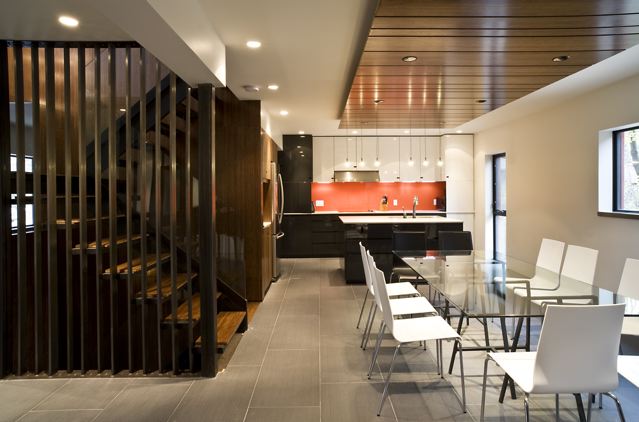
xisting swimming pool and large yard.
There is a long list of green features in the home, however a few highlights stand out:
- Rooftop PVT solar panels produce electricity under the Ontario government’s MicroFIT program and thermal hot water for pool heating;
- Concrete cistern collects rainwater from the roof;
- A layered combination of spray-foam polyurethane and mineral wool for R35 insulation values in the roof and walls;
- No air conditioning – house is kept cool and comfortable in the summer with ceiling fans and large operating windows;
- Choice of materials, including bamboo hardwood floors, fiberglass triple-glazed windows providing passive solar heating in winter, dual flush toilets, LED lighting in kitchen, low and no VOC paints and finishes;
- In-floor radiant heat, efficient air handler with attached HRV circulates air throughout the house;
- And heated basement floor.
Using products by Demilec Inc., which provides environmentally-friendly, high-performance polyurethane insulation systems to residential and commercial developers across five continents, SevernWoods was able to enhance the insulation value of the house, as well.
Ms. Chan stressed that anyone undergoing a detailed green reno should be prepared for “back-and-forth” with all parties from start to finish.
“For example, we worked with the mechanical designer – Dara Bowser of Bowser Technical Inc. – off and on throughout the process,” she says. “From asking him to model different levels of insulation, wall designs and window types to methods of heating/cooling to limit overall energy use.
“Also, based on one of his suggestions, we pushed for a large rainwater cistern for toilet and garden use and drain water heat recovery.”
There was also a second architect, Antonio Santini of Red Studio Architects, involved in the project – for interiors. The structural engineer was David Moses of Moses Structural Engineers.
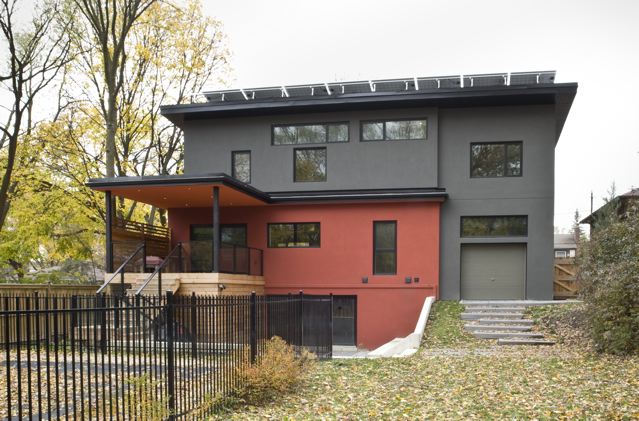
Ms. Kuhn said she spent a lot of time looking for a more contemporary design for the home – it had already been renovated once by a previous owner – trying to maximize the clients’ spatial requirements while keeping the project within their budget.
For others considering a whole-scale green renovation, Ms. Chan says it’s important to take the time to find the right contractors.
“Whether it is the right architect, general contractor, engineer, or HVAC designer, you really need to feel comfortable with the capability and working style of those individuals involved,” she adds.
Web: www.severnwoods.com / www.mekarch.ca
World’s largest wooden structure
Spain’s Metropol Parasol a magnet for tourists, with a honeycomb design featuring museum, farmers’ market, elevated plaza and panoramic terrace
Its claim to fame – recognition as the world’s largest wooden structure.
That headline-grabbing hook, however, only underscores the amazing design qualities of Metropol Parasol, the redevelopment of the Plaza de Encarnacion in Seville, Spain.
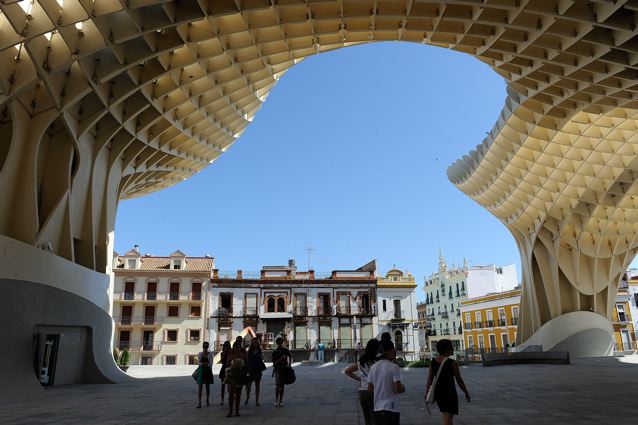
The project, completed over the course of seven years by Jurgen Mayer H. Architects, reasserts the central arcade as a community meeting place and market. And it’s quickly becoming a magnet for tourists and locals alike.
Offering an architectural museum, a farmers’ market, an elevated plaza, multiple bars and restaurants, as well as a panorama terrace overlooking the entire space and neighbourhood, the project reaffirms Seville’s spot as one of the world’s most fascinating cultural destinations.
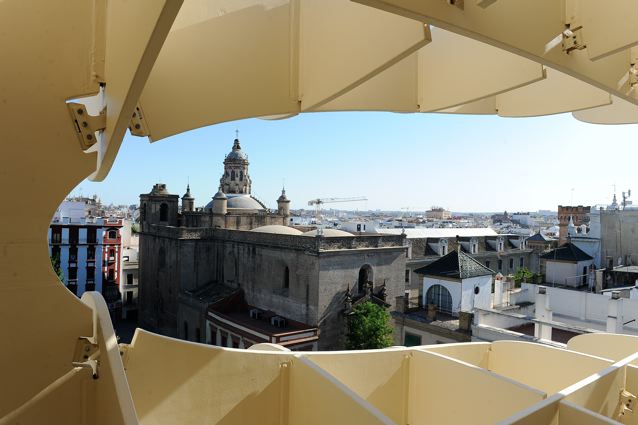
Accented by a series of undulating parasols, Metropol’s interlocking honeycomb of wooden panels rise from concrete bases, which are positioned to form canopies and walkways below the parasols.
The German architect’s goal with Metropol Parasol’s neutral tone was to help harmonize the stark contrast of ultra-modern structure with the medieval surroundings of Seville.
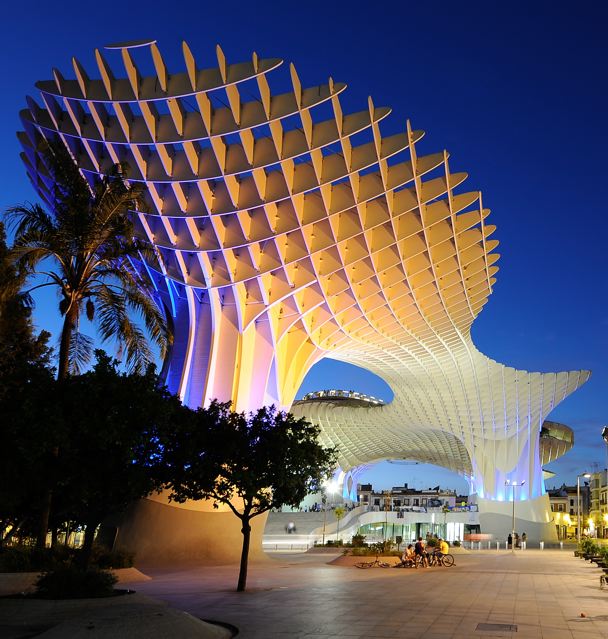
Stairways and storefronts sit below the wooden parasols of the innovative structure, which is made from bonded timber with a polyurethane coating.
Originally, the site was slated to become a parking garage, but after excavations revealed archeological findings, the city of Seville decided to make the site a museum and community centre.
The building, popularly known as Las Setas de la Encarnación (Incarnación’s mushrooms), was completed in April 2011 and has dimensions of 150 by 70 metres (490 by 230 feet), with an approximate height of 26 metres (85 feet).
The structure consists of six parasols in the form of giant mushrooms, whose design is inspired by the vaults of the Cathedral of Seville and the Cathedral of Seville and the ficus trees in nearby Plaza de Cristo de Burgos.
Metropol Parasol is organized over four levels. The underground level (Level 0) houses the Antiquarium, where Roman and Moorish remains discovered on-site are displayed in a museum. Level 1 (street level) is the central market. The roof of Level 1 is the surface of the open-air public plaza, shaded by the wooden parasols above and designed for public events. Levels 2 and 3 are the two stages of the panoramic terraces (including a restaurant), offering one of the best views of the city centre.
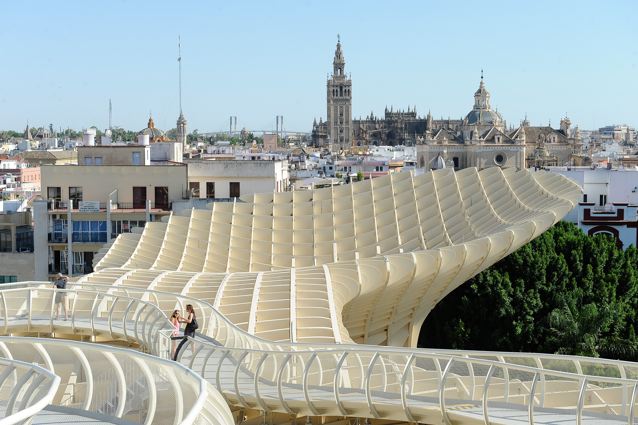
A little history: since the 19th century, a market was located in the plaza, housed in a market building. The building was partially torn down in 1948, according to plans for urban renewal. The market itself remained, however, until 1973, when the rest of the dilapidated building was finally torn down. The land remained dormant until 1990, when the city decided to construct underground parking with space for a market on top.
In the the midst of construction, however, ruins dating to Roman and Andalusian eras were discovered, and construction was frozen after an expenditure of 14 million euros. In 2004 the city decided to attempt to develop the area again, and opened an international competition to solicit bids.
Mayer, 45, who spoke at the Interior Design Show in Toronto in January 2013, has said that the forms of his buildings were inspired by the vaults of Seville’s expansive cathedral and that he wanted to create a “cathedral without walls.”
To that end, the building differs from others of its kind, in that it is not a closed institution, locked at night, but a place that can be used at all times.
A reviewer noted that it catches and holds views from side streets, and from inside the new structure looking out.
“The Metropol Parasol offers much more than a vision of architectural beauty, it’s a breathtakingly modern interpretation of an urban centre, a place to be inspired but also to do the everyday things you do in city life.”
Web: jmayerh.de
Founded in 1996, J. MAYER H. Architects focuses on works at the intersection of architecture, communication and new technology. Founder and principal Jürgen Mayer H. has received both national and international awards, including the Mies-van-der-Rohe Award for emerging architects in 2003, the Holcim Award Bronze in 2005, and the Audi Urban Future Award in 2010.
Working together
CaraCo Development reaps benefits of innovative project partnership with Union Gas
CaraCo Development Corporation is attracting attention from cost-conscious new home buyers.
The Kingston-based company, known as a leader in lifestyle development, recently entered into a agreement with Union Gas under the utility’s Optimum Home Program, which partners some of Ontario’s leading builders with expert building science consultants.
The project – dubbed Performance Home 2020 – was the result of a challenge for CaraCo to build a high-performance home that was 20 per cent above the Ontario Building Code requirements.
And CaraCo delivered – and then some, says Ken Dantzer, CaraCo’s design manager. So much so, that CaraCo has been awarded the ESC (Energy Solutions Centre) Partnership Award in recognition for its joint efforts with Union Gas.
The ESC award, from the non-profit organization of energy utilities and equipment manufacturers that promotes energy efficient natural gas solutions and systems for use by residential, commercial, and industrial energy users, signifies customer recognition of the benefit of working in partnership with a local utility.
That, plus the unique aspects of the project itself, has helped to pique interest from consumers.
“The attention to detail in the specifications and the conformance with future building codes has been well received by the public,” says Dantzer. “We have generated a lot of local interest through weekly advertising and radio, inviting the public to visit the model home. Educational signage is posted throughout, including a six-foot wide diagram explaining the home’s features and improvements, so visitors can learn about how they can benefit in comfort, in savings, and security of investment.”
The CaraCo Performance Home 2020 features several leading-edge building design and construction technologies, offering homebuyers improved comfort, better indoor air quality, and tools to efficiently control energy use, resulting in lower utility bills.
With Performance Home 2020, CaraCo has cemented its reputation as a leader in innovative development with accomplished past projects including homes built to the ENERGY STAR® for New Homes Standard, R-2000 homes, LEED certified, as well as incorporating standard features that are environmentally conscious and energy efficient. The Performance Home 2020 utilizes best practice technology cost effectively with minimal increase to sale price.
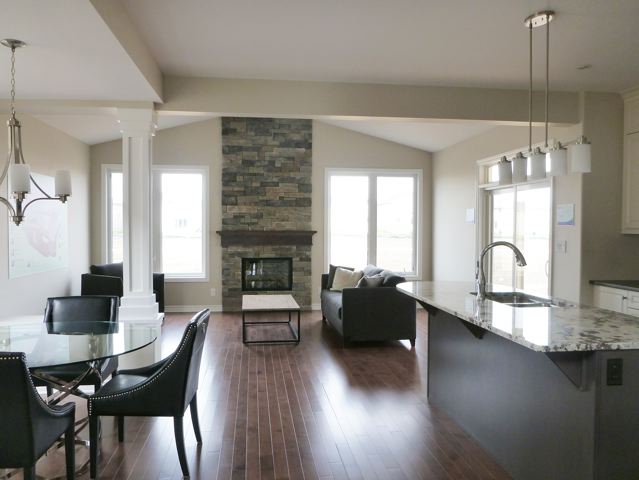
CaraCo, also known for leading the way in innovative building standards in Ontario, will be utilizing the success of the prototype Performance Home 2020 at 827 Augusta Drive in Kingston to build its business – with formalized specifications now in place, the system will be implemented into about 10 per cent of the company’s housing.
“As with many initiatives such as the CaraCo Performance Home 2020, LEED, and ENERGY STAR® that we are utilizing, the process of developing a real project under their guidelines helped to refine our specifications and train our suppliers and trades as to what specifications are required,” says Dantzer. “This could apply to local sourcing, efficiency, chemical composition and quality control.
“We have found this process invaluable, and continues to drive change within our specifications. We will continue to seek the forthcoming regulation to elevate our product and continue to lead the way ahead of our competition.”
Web: www.caraco.net
A family-owned company, CaraCo Development Corporation has been building houses in Kingston since 1986. CaraCo Development Corporation has maintained an excellent rating for after sales service consecutively since incorporation in 1986, achieving the highest ‘After Sales Service Achievement recognition’ award from Tarion, and the ONHWP ‘President’s Award,’ placing CaraCo’s service record among the highest in Ontario.







